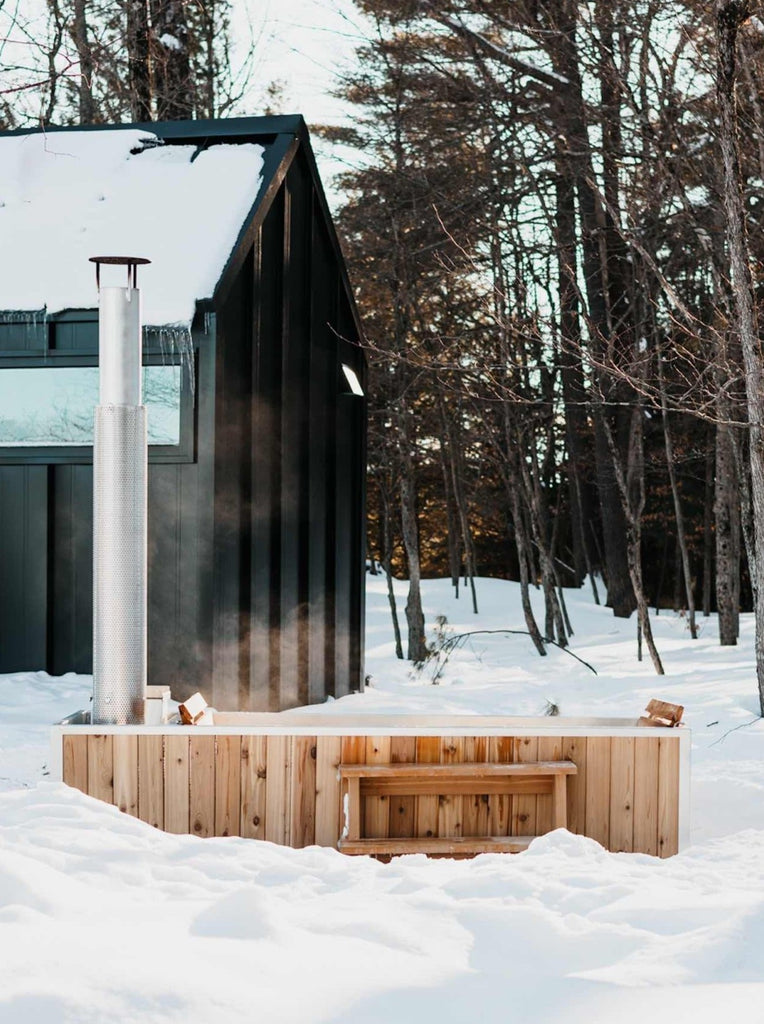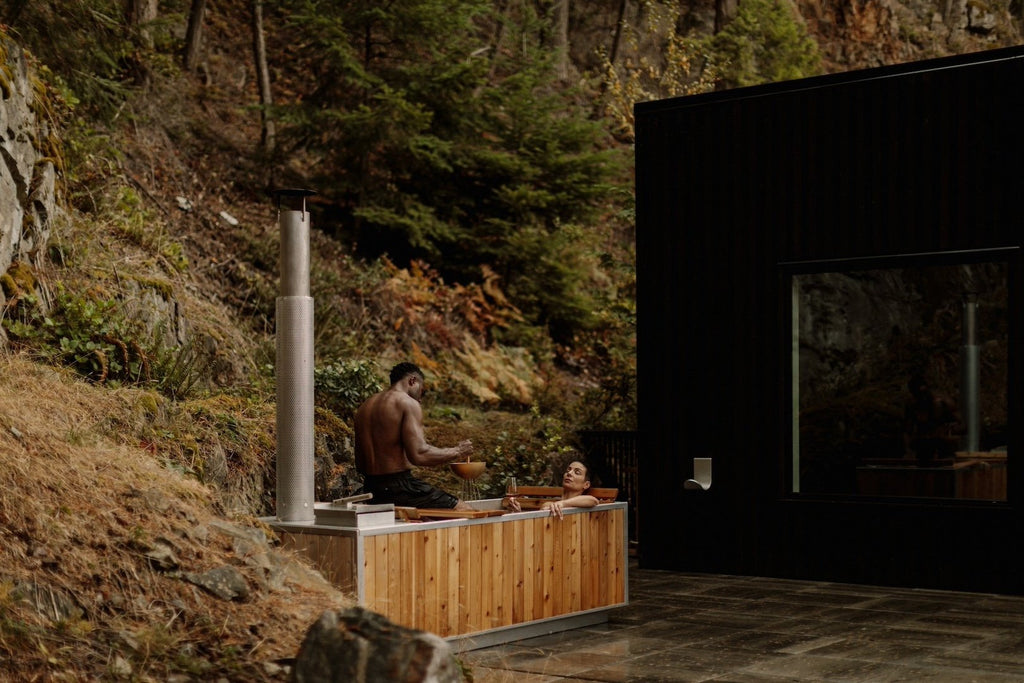When choosing a greener lifestyle, we are making conscious choices to reduce our environmental impact on the planet. As we become acutely aware of how our purchases and lifestyle habits affect the environment, we spend more time evaluating environmental, sustainable and eco-friendly aspects of the products we love.
This brings into question, what should we be taking into account when looking for natural and eco-friendly hot tub options?

What is Eco-Friendly?
First, let’s get on the same page with some brief definitions of what these phrases mean.
“Eco-friendly” means earth-friendly or not harmful to the environment, according to Merriam–Webster. For consumer products that means keeping both environmental and human safety in mind, as well as considering the impact of all aspects of production from raw materials to packaging.
Eco-friendly product attributes include:
- Non-toxic
- Sustainably grown or sourced elements, produced in a way that doesn’t deplete the ecosystem
- Made from recycled, reclaimed, or renewable materials
- Low carbon footprint
- Biodegradable, e.g. materials or waste naturally decomposes and is less taxing on landfills and the earth
What is Sustainable?
“Sustainable” is defined as “a method of harvesting or using a resource so that the resource is not depleted or permanently damaged.” Sustainability practices guide us in maintaining our environment. It assumes that resources are finite and should be used thoughtfully. Sustainable living is about making conscious decisions about the use of the earth's natural resources and keeping future generation's needs in mind.
Let’s look at nine considerations for a more eco-friendly hot tub:

1 / Energy Efficient
Electric hot tubs consume a wealth of energy in order to heat the water 24/7/365. Many oversized models have terrible energy profiles because the water is constantly kept hot,
ready to be used at any moment.
When electric spas with all the bells and whistles are in use - lights, jets, music - it significantly bumps up this energy draw. The effects of heating a hot tub in the winter in a cold climate is reflected in the cost of maintenance too. If the hot tub’s electricity is derived from ‘dirty’ energy sources such as coal and natural gas, the situation is even worse in terms of energy efficiency and environmental impact.
A great eco-friendly hot tub option uses solar-powered electricity. Another viable solution is a heat exchange panel, although this technology is only available to sunny climates as it requires six hours of sunlight per day. You could also research the most energy-efficient electric hot tubs available, much like you would with any home appliance. But better yet, you could choose the option that goes off the grid completely and use a wood burning hot tub—the only truly sustainable resource for heating, since you heat it when you need it.

2 / Chemical Free Hot Tub
It’s safe to say that if you’re looking for something environmentally conscious, a chemical-free soak in a hot tub is high on your list of prerequisites. Chemicals used in hot tubs can leak into the environment, causing degradation of the soil, killing plants, and poisoning wildlife.
Not only is a non-toxic soaking experience hypoallergenic, it also eliminates skin and lung irritations, and removes the intense odor of chlorine and chemical additives. And when it’s time to change the water, it makes the disposal of dirty water less taxing on the environment.
In recent years ‘eco-chemicals’ like natural enzymes and natural sanitization systems have been developed to help prolong the hot tub water’s life and keep it safe, i.e. manage bacterial growth levels. However, by choosing to go with a natural water hot tub instead you’ll save yourself the hassle, expense, and continual upkeep with complicated sanitization systems.
There are several ways to extend the life of your chemical free hot tub water and still keep it clean. The best way is to cleanse your body before soaking (similar to the Japanese bathing tradition). Another way is to regularly clear the tub of debris with a pool skimmer and to use a hot tub cover when not in use. In the GOODLAND Hot Tub, the untreated water can be used for 1–2 weeks of regular daily use.

3 / Salt Water Hot Tub
Treating and replacing hot tub water regularly to keep it safe adds up to significant water use for hot tubs—and wastage, if the water cannot be recycled.
Salt water hot tubs are a non-toxic alternative to chemicals. Salt water has a gentler feel and provides a sense of buoyancy.
There’s a range of salt water options depending on your type of hot tub, from using actual seawater to installing a salt water system. The former option is the most eco-friendly since seawater is a plentiful renewable resource. The latter option produces a natural chlorine through its generator which keeps the tub clean. If you’re considering a wood heated hot tub, find out if it functions with both salt and fresh water (the GOODLAND hot tub accommodates both types of water).

4 / Recyclable Water
Natural water hot tubs use water from the tap, lake, river, and rain. Depending on your hot tub type and local bylaws, you may be able to recycle chemical-free hot tub water. Old hot tub water (also known as ‘gray water’) can be put to good use for washing the deck or watering the garden.

5 / Uses Sustainable Materials
Sustainable materials refers to using renewable resources in a way that ensures the supply can meet the demand. This concept also considers the effort required to maintain these materials and their lifespan.
In hot tub manufacturing, the most sustainable material options are wood and metal. Unfortunately most hot tubs in Canada and the United States are made from plastics which don’t have the expected product lifespan and require considerable upkeep. For more detail on this topic, read our article comparing hot tub shell materials.
Wood
Wood is a sustainable resource when it's harvested responsibly from managed forests, and trees can be continually replenished. Sustainably managed forests are a crucial part of reducing the impacts of climate change.
Look for recommendations and forest certification from organizations such as FSC and Sustainable Forestry Initiative. Western red cedar is one of the best woods to utilize as it comes from the most sustainably managed forests in the world in British Columbia, Canada.
Metals
Metals are some of the most sustainable and efficient materials available, and can be recycled infinitely.
The topic of hot tub ‘afterlife’ or recycling is important to note here. A hot tub will have a large environmental impact if its parts aren’t recyclable. The fibreglass and plastic spas are the hot tub shells that end up in the landfill.
As natural materials, wood and metal are fully recyclable. Metal’s recovery rates are very high at close to 100%.
But who’s going to recycle a handcrafted wood hot tub? It’s going to be passed down through the family—sustainable hot tubs have the huge advantage of longevity.

7 / Manufactured Domestically
If sustainability is very important to you, choose a domestically sourced hot tub. Many large, heavy electric hot tubs are manufactured overseas and shipped to North America. To reduce the carbon footprint involved in the manufacturing process, seek out a hot tub that is built closer to home from domestic materials and support the local economy.
8 / Insulation
Just like an energy-efficient home that’s insulated effectively, your hot tub needs insulation too. When properly insulated, the hot tub requires less energy to keep the water warm when you’re in it.
Look for insulation surrounding the tub sides and underneath. With the addition of an insulated hot tub cover (rigid foam floating on top of the water, topped by a fitted canvas cover), you’ll keep the water at a higher temperature so it heats up more efficiently the next time you use your tub—especially when you're soaking in the winter.

9 / Reasonable Size
Large hot tubs require approximately 400–500 gallons of water, a limited resource in some areas particularly during drought season. Buy only the hot tub size that you need and keep the environmental impact low from water and energy consumption to transportation costs.
Purchasing any type of hot tub is an investment that requires careful consideration—especially when it comes to making greener lifestyle choices. With a smaller footprint than traditional round tubs, the GOODLAND Wood Burning Hot Tub has a water capacity of only 210 gallons (800 L), making it the fastest to fill, drain, and heat up.
What About Smoke?
As wood burning hot tub fans, we get asked about smoke and its effect on the environment. Our short form response: if you manage the fire properly there should be little to no smoke.
In recent years, there’s a tendency to consolidate all smoke as ‘bad’, but smoke from a coal-burning factory or other industrial byproduct is not the same smoke from a small, controlled stove fire. In other words, naturally-occurring smoke is different from unnatural smoke.
Smoke consists of a mix of gases and tiny particles (‘soot’) produced by the material or fuel that you’re burning. The gases include carbon dioxide (CO2), carbon monoxide, and water vapour but may include other things depending on the material. For example, coal burning is considered more toxic than wood burning because it contains higher levels of sulfur, heavy metals, and other harmful compounds.

When burning wood, the presence and concentration of each gas depends on the wood type and its condition. Find more information on this under “How to Avoid Smoke . . .” below.
With firewood combustion, the CO2 emissions are considered “carbon-neutral” because the amount of CO2 emitted is essentially equivalent to the amount of CO2 trees need to grow the same quantity of wood. The combustion of wood does not contribute to the net increase in atmospheric levels of CO2 in the same way as the combustion of fossil fuels.
The solar energy that supported the tree’s growth and was stored in the tree is also released, adding to the natural balance of the climate rather than introducing an excess of CO2 into the atmosphere. In other words, wood-burning stoves are carbon-neutral.
Small wood burning appliances like a hot tub wood stove tend to use less wood and generate less smoke than an open fire in a fireplace, fire pit, or chiminea.

How to Avoid Smoke with Your Fire
When you learn how to efficiently burn wood, it reduces the smoke. This involves choosing the right firewood - dry seasoned or kiln-dried - and setting it correctly so that air can circulate. A smoldering fire causes smoke.
Smoke from a fire is often the result of burning wood that hasn’t been dried effectively. For little to no smoke, avoid the following:
- Wet wood
- Green wood (newly chopped down)
- Wood covered in moss/lichen/fungus/sap
- Forest debris (if not bone dry)
- Building materials or household garbage
- Softwood - best as kindling or firestarter, it burns faster
When you gradually build your fire up, slowly adding slightly larger pieces, and adjusting the ventilation, you can avoid unnecessary smoke.
Building the fire takes time and attention. Avoid overfilling the stove in order to ignore it. Instead, embrace the process of prepping, creating, and maintaining the fire—it’s a vital part of the outdoor soaking experience, what we at GOODLAND call the ‘90-minute ritual’ of slowing down and reconnecting with what matters in life.
This video shows you how to do this with the GOODLAND Wood Burning Hot Tub.
We understand that some cities have air pollution issues and wood smoke can be subject to municipal or regional regulations. Be sure to follow the regulations outlined in your area.



